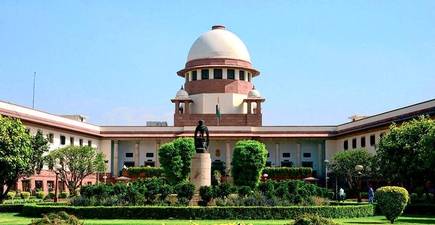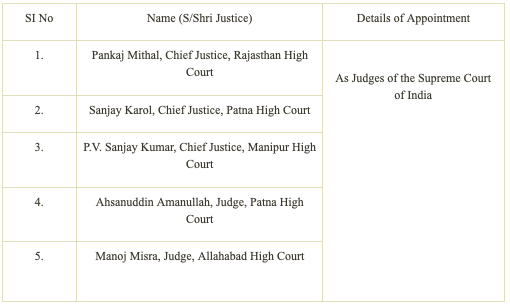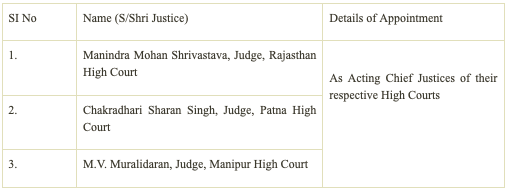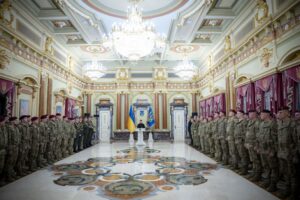
The Supreme Court of India
Executive Versus Judiciary: A murky tussle
New Delhi: The ongoing tussle between the Supreme Court and the Centre over the appointment and transfer of judges is getting murkier day by day with both adopting aggressive positions. In a new development, the Supreme Court toughened its stand on the delay by the government in the implementation of the collegium’s recommendation for the elevation and transfer of High Court judges. In fact, the Apex Court on February 3, 2023, set a new deadline to clear the pending issue of the elevation of five judges to the Supreme Court.
The Supreme Court warned that it would be forced to take ‘unpalatable’ and ‘difficult’ decisions if the Centre does not clear the judges’ elevation by February 13, 2023. In an unusual statement, the apex court said that the collegium recommended five names on December 13, 2022, and ever since they are pending. The collegium headed by Chief Justice DY Chandrachud on January 31 also recommended Allahabad and Gujarat high court chief justices to the Supreme Court.
In fact, the two-member Supreme Court bench— justices SK Kaul and AS Oka—also took umbrage at the Centre’s delay in clearing the transfers of 11 High Court judges, including a Chief Justice, despite two reiterations by the collegium. Under the rules, even one reiteration is enough to clear the pending by the Centre. Some of these 11 names have been awaiting clearance since last November.
The court’s point seemed to be that since transfers are administrative decisions and do not require any intelligence inputs about a candidate’s credentials, there could be no reason for the government to withhold clearance. The tenor in which the bench expressed its mind on Friday, February 3, 2023, made it somewhat awkward for Attorney General R Venkataramani to defend the Centre. The Attorney General assured the court that President Draupadi Murmu would issue the warrant of appointment relating to the five judges by Sunday, February 5. However, the bench had given him time for 10 days but the President, after consultation with the Chief Justice of India, today itself appointed the five Chief Justices/ Judges of High Courts as Judges in the Supreme Court of India. The details were as follows :

The President today also appointed the following senior-most Judges of High Courts of Rajasthan, Patna and Manipur as Acting Chief Justices in that High Courts:

Before these appointments, the sharp observations from the bench came amid an escalating tussle between the Judiciary and the Centre over recurring delays in government approval for the collegium’s recommendations, and over which of them should have supremacy in judges’ appointments and transfers. The real issue here seemed to be that the Union Government is batting for a new system and reform in the appointment of judges. The Supreme Court wants the present collegium system to continue.
Moreover, legal pundits feel that today’s gesture is only a temporary truce with the judiciary. The tussle and the cold war is expected to continue in the days to come on various judicial matters including the pending issue of the transfer of judges.
As the power tussle continues over the appointment of judges in the Supreme Court and High Courts, Law Minister Kiran Rijiju, who has been consistently and openly opposing the collegium system, came with a suggestion to have a government representative in the Supreme Court collegium, which really added fuel to the fire. Further, the Vice President of India Jagdeep Dhankar observed that Parliament is supreme and has unlimited powers to amend the Constitution.
In other words, the Union Government tried to indicate that the Executive is supreme over the Judiciary and it would not agree to the Supreme Court collegium as well as the striking down of the National Judicial Appointment Commission (NJAC) by the apex court. This has opened the debate about the unlimited power of the Parliament, including amending the basic structure of the Constitution, or is it subject to inherent limitations?
Chief Justice Chandrachud compared the basic structure of the Constitution to the North Star, an unfailing guide which shows the way when the path appears convoluted. His observation marks the response of the Supreme Court to the statement made by Vice President Dhankar. The opinion of the Vice President and the reply from the top judge have come amidst an ongoing verbal skirmish initiated by the government over the striking down of the 99th Constitutional Amendment and the controversial NJAC.
*Senior journalist


 By
By 


